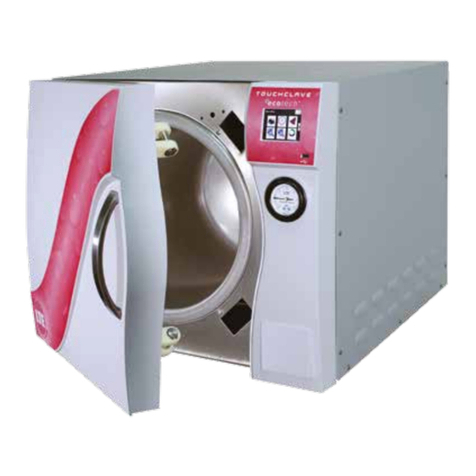
Page 5 of 35
CONTENTS
1. GENERAL................................................................................................................7
1.1 Scope of User Manual........................................................................................7
1.2 Classification of User Levels .............................................................................7
1.3 Overview of Touchclave-R autoclaves .............................................................7
1.4 Safety precautions..............................................................................................8
2. MAIN FEATURES AND OPTIONS OF THE TOUCHCLAVE-R RANGE ....9
2.1 Standard features...............................................................................................9
2.2 Optional features................................................................................................9
2.3 Load capacities .................................................................................................10
2.4 The cycle sequence ...........................................................................................10
2.5 Typical cycles....................................................................................................12
3. THE CONTROL SYSTEM – COMMANDS AND SCREEN TYPES .............13
3.1 Commands ........................................................................................................13
3.2 Process screens .................................................................................................13
3.3 Menu screens ....................................................................................................13
3.4 Password and batch code screens...................................................................14
3.5 Parameter screens............................................................................................14
3.6 Warning and confirmation screens ................................................................15
4. THE CONTROL SYSTEM – OPERATING THE DOOR................................16
4.1 Locks .................................................................................................................16
4.2 Restrictions on door operation .......................................................................16
5. THE CONTROL SYSTEM – RUNNING A CYCLE ........................................17
5.1 Starting the cycle..............................................................................................17
5.2 Cycle in progress ..............................................................................................18
5.3 Faults.................................................................................................................18
5.4 Cooling Override..............................................................................................19
5.5 Finishing the cycle............................................................................................19
5.6 Sample cycle printout ......................................................................................20
6. THE CONTROL SYSTEM – RUNNING A CYCLE ........................................21
6.1 Menu access tree for supervisors and operators...........................................21
6.2 Initial Access.....................................................................................................22
6.3 Data Archiving .................................................................................................22
6.4 View/Print Last Cycle......................................................................................23
6.5 Set Time/Date ...................................................................................................23
6.6 Alarms...............................................................................................................23
6.7 Status.................................................................................................................23
6.8 Cycle Setup .......................................................................................................24
6.9 User Setup.........................................................................................................26
6.10 Cooling Override............................................................................................26
7. CARE AND MAINTENANCE.............................................................................28
7.1 Door seal ...........................................................................................................28
7.2 Fitting a replacement seal ...............................................................................29
7.3 Cleaning and draining the chamber...............................................................30
7.4 Printers – instructions for paper installation ................................................30
7.4 Printers – instructions for paper installation ................................................31
7.5 Spare parts – consumable ...............................................................................33
8. AFTER SALES SERVICE………………………………………………………33




























